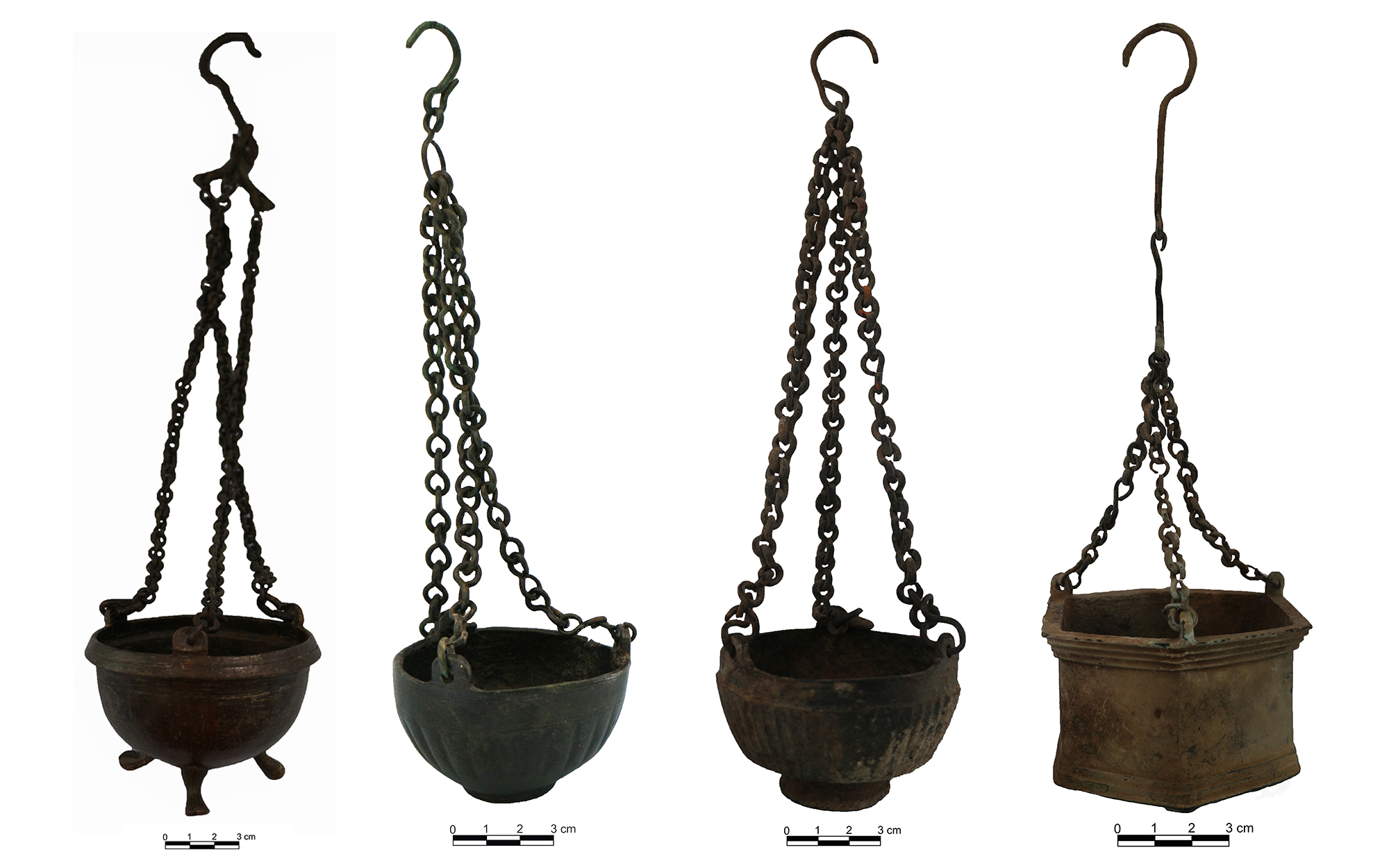Byzantine Bronze Censers in the Konya Archeological Museum
Yurdagül ÖZDEMİR
Abstract
The subject of our study is the bronze censers in the Konya Archaeological Museum and dated to the Byzantine (East Roman) Period. The censer, in which incense is burned and used in religious ceremonies and daily life, has a special place in the Christianity. According to Christianity, incense rising to the sky symbolizes the prayers of the worshipers reaching God. From the Early Byzantine Period to the Late Byzantine Period, it is known through written sources, descriptions and surviving examples that censer was used in church rites, funerals or important events affecting the society.
There are eleven bronze censers included in the Konya Archaeological Museum collection through purchase and confiscation. These censers are similar to the Byzantine Period censers found in museums and collections in Turkey and abroad, in terms of form, material, technique and decoration. However, none of these censers in the museum collection have a distinctive religious subject, symbol or figure. In this period, there is no definite data on the difference in the use of decorated and undecorated censers in religious and daily life. Therefore, censers can be liturgical items used in Byzantine religious ceremonies or items used in daily life. The censers discussed in the study were examined according to their form, technique and ornamental features, and were dated by comparing them with the examples found in museum collections in Turkey and abroad. Our study is important in terms of defining the censers in the Konya Archeological Museum collection in detail for the first time and adding new findings to the rich examples of Byzantine metalwork.
Acara, M. (1990). Türkiye Müzeleri’ndeki Bizans Maden Eserleri. [Yayımlanmamış Yüksek Lisans Tezi] Hacettepe Üniversitesi.
Acara, M. (1997). Bizans Maden Sanatı’nda Dini Törenler Sırasında Kullanılan (Liturjik) Eserler. [Yayımlanmamış Doktora Tezi], Hacettepe Üniversitesi.
Acara-Eser, M. (2007). Liturjide ve Günlük Kullanımda Maden Sanatı. A. Ödekan (Ed.) “Kalanlar” 12. ve 13. Yüzyıllarda Türkiye’de Bizans/ “The Remnants” 12th and 13th Centuries Byzantine Objects in Turkey (ss. 37-42). ANAMED
Acara-Eser, M. (2011). Sivas Arkeoloji Müzesi’nde Yeni Bulunan Bir Buhurdan. Anadolu ve Çevresinde Ortaçağ, 5, 143-162.
Acara-Eser, M. (2020). Bizans Maden Sanatı: Dini Törenlerde Kullanılan (Liturjik) Eşyalar. Bilgin Kültür Sanat Yayınları.
Akyürek, E. (1996). Bizans’ta Sanat ve Ritüel. Kabalcı Yayınevi.
Aydın, A. (2009). Burdur ve Side Müzesi’ndeki Figürlü İki Buhurdan, Adalya, XII, 277-297.
Altun F. İ. (2020). Kapadokya Kaya Kiliselerinde Buhurdan Tasvirleri. Hacettepe Üniversitesi Edebiyat Fakültesi Dergisi, 37(1), 116-135.
Altun, F. İ. ve Erginer, G. E. (2020). İzmir Arkeoloji Müzesi Envanterine Kayıtlı Bir Grup Bronz Eser. Sanat Tarihi Dergisi, 29(2), 541-565.
Atasoy, S. ve Parman, E. (1983). Byzantine Art. The Anatolian Civilisations, Greek/Roman/Byzantine II: (ss. 137-199). Türkiye Cumhuriyeti Kültür ve Turizm Bakanlığı.
Atasoy, S. (2005). Halûk Perk Koleksiyonu’ndan Bronz Kandiller. Ş. Dönmez (Ed.) Tuliya I (ss. 193-230). Halûk Perk Müzesi Yayınları.
Bauras, B. ve Kazdhan, A. (1991). “Censers”, The Oxford Dictionary of Byzantium, I (s. 397). Oxford University Press.
Buckton, D. (1994). Byzantium, Treasures of Byzantine Art and Culture from British Collections. British Museum Press.
Crawford, J. S. (1990). The Byzantine Shops at Sardis. Harward University Press.
Stathatou, H. A. ve Amandry, P. (1963). Collection Héléne Stathatos, III: Objects Antiques et Byzantins. En dépot chez P. Amandry.
Demirel-Gökalp, Z. (2016). Kütahya Müzesindeki Bazı Maden Eserler. Kütahya Müzesi 2015 Yıllığı. “50. Yıl Anısına” (ss. 241-268). Bilgin Kültür Sanat Yayınları.
Erdem, S. (1992a). “Buhur”, Diyanet Vakfı İslam Ansiklopedisi, 6 (ss. 383-384). Türkiye Diyanet Vakfı İslam Araştırmaları Merkezi.
Erdem, S. (1992b). “Buhurdan”, Diyanet Vakfı İslam Ansiklopedisi, 6 (ss. 384-385). Türkiye Diyanet Vakfı İslam Araştırmaları Merkezi.
Erginsoy, Ü. (1978). İslam Maden Sanatının Gelişmesi (Başlangıcından Anadolu Selçukluların Sonuna Kadar). Kültür Bakanlığı Yayınları.
Evangelatou, M. (2005). The symbolism of the censer in Byzantine representations of the Dormition of the Virgin. M. Vassilaki (Ed.) Images of the Mother of God. Perceptions of the Theotokos in Byzantium (ss. 117-125). Ashgate Publications.
Evans, H. C. ve Wixom, W. D. (1997). The Glory of Byzantium, Art and Culture of the Middle Byzantine Era, A.D. 843-1261. Metropolitan Museum of Art.
Foss, C. (1976). Byzantine and Turkish Sardis. Harvard University Press.
Gürler, B. (2004). Tire Müzesi Bronz Eserleri. Ege Yayınları.
Kitabı Mukaddes, Eski ve Yeni Ahit, (Tevrat, Zebur, (Mezmurlar) ve İncil), (2003). Kitabı Mukaddes Şirketi Yayınları.
Karagöz, Ş. (2010). Marmaray-Üsküdar Kazılarında Ortaya Çıkarılan On İkinci ve On Üçüncü Yüzyıl Yapısı. A. Ödekan, E. Akyürek ve N. Necipoğlu (Eds.) 1. Uluslararası Sevgi Gönül Bizans Araştırmaları Sempozyumu (ss. 413-423). ANAMED.
Köroğlu, G. (2005). Bizans Dönemi Buhurdanları ve Halûk Perk Müzesi’ndeki Örnekler. Ş. Dönmez (Ed.), Tuliya I (ss. 261-308). Halûk Perk Müzesi Yayınları.
Köroğlu, G. (2015). Erken Bizans Döneminde Buhur-Buhurdan Kullanımı ve Mersin Müzesi’ndeki Buhurdan Örnekleri, Seleucia ad Calycadnum, 5, 51-77.
Peker, N. (2010), Gülşehir Karşı Kilise Duvar Resimleri. A. Ödekan, E. Akyürek ve N. Necipoğlu (Ed.) 1. Uluslararası Sevgi Gönül Bizans Araştırmaları Sempozyumu Bildirileri (ss. 572-581). ANAMED.
Perlzweig, J. (1961). Lamps of the Roman Period: First to Seventh Century after Christ, Agora VII. American School of Classical Studies.
Richter-Siebels, I. (1990). Die palästinensischen Weihrauchgefässe mit Reliefszenen aus dem Leben Christi. Zentrale Universitäts-Druckerei.
Taft, R. F. ve Kazdhan, A. (1991). “Incense”. The Oxford Dictionary Byzantium, 2 (s. 991). Oxford University Press.
Waldbaum, J. C. (1983). Metalwork from Sardis: The Finds Through 1974. Harvard University Press.
Weitzmann, K. (1979). Age of Spirituality. Late Antique and Early Christian Art, Third to Seventh Century. Catalogue of the exhibition at the Metropolitian Museum of Art. Metropolitian Museum of Art.
Özdemir, Y. (2022). Konya Arkeoloji Müzesi’nde Bulunan Bizans Dönemi Bronz Buhurdanlar. Arkhaia Anatolika, 5, 224-251. https://doi.org/10.32949/Arkhaia.2022.49



